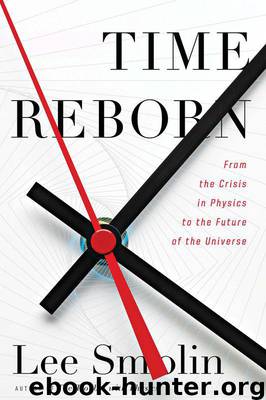Time Reborn: From the Crisis in Physics to the Future of the Universe by Lee Smolin

Author:Lee Smolin [Smolin, Lee]
Language: eng
Format: epub
Publisher: Houghton Mifflin Harcourt
Published: 2013-04-22T20:00:00+00:00
15. The Emergence of Space
THE MOST MYSTERIOUS aspect of the world is right in front of us. Nothing is more commonplace than space, yet when we examine it closely, nothing is more mysterious. I believe that time is real and is essential for a fundamental description of nature. But I think it likely that space will turn out to be an illusion of the sort that temperature and pressure are—a useful way to organize our impressions of things on a large scale but only a rough and emergent way to see the world as a whole.
Relativity theory merged space with time, leading to the block-universe picture, in which both space and time are understood to be subjective ways of dividing up a four-dimensional reality. The hypothesis of the reality of time frees time from the false constraints of this unification. We can develop our ideas of time with the understanding that time is very different from space. This separation of time from space liberates space, too, opening a door to a greater understanding of its nature. As we’ll see in this chapter, it leads to the revolutionary insight that space, at the quantum-mechanical level, is not fundamental at all but emergent from a deeper order.
The simple fact that the world of everyday objects is organized in terms of “near” and “far” is a consequence of two basic features of reality: the existence of space and the fact that things have to be in our neighborhood to affect us (the property that physicists call locality). The world is full of things that represent either danger or opportunity, yet at any one time you aren’t concerned with most of them. Why? Because they’re far away from you. The tigers in countries across the ocean would eat you in a minute if they could, but you needn’t worry, because they’re nowhere near you. This is the gift of space; almost everything is far away from us and can be ignored for the time being.
Imagine a world containing an enormous variety of objects without the organization of space. Anything might impinge on anything else at any time. There would be no distance to keep things separated.
We are acutely aware, through our senses, of what’s close to us. But not much is. It is a feature of space that not many things can occupy the spaces closest to you. This is a consequence of space’s low dimensionality. Think of how many neighbors live directly next to you. Just two families, one on each side. Now, how many neighbors could be directly adjacent to you? Four—two families next door, one across the street, and one in back. If you live in an apartment building, the number of neighbors closest to you grows to six, because there are also the people underneath you and the college kids who listen to television until three in the morning just above. The number of neighbors nearest you grows proportionally to the number of dimensions—two in one dimension, four in two dimensions, six in three dimensions.
Download
This site does not store any files on its server. We only index and link to content provided by other sites. Please contact the content providers to delete copyright contents if any and email us, we'll remove relevant links or contents immediately.
| Aeronautics & Astronautics | Astronomy |
| Astrophysics & Space Science | Comets, Meteors & Asteroids |
| Cosmology | Mars |
| Solar System | Star-Gazing |
| Telescopes | UFOs |
Tools of Titans by Timothy Ferriss(8303)
Turbulence by E. J. Noyes(7977)
Secrets of Antigravity Propulsion: Tesla, UFOs, and Classified Aerospace Technology by Ph.D. Paul A. Laviolette(5330)
Astrophysics for People in a Hurry by Neil DeGrasse Tyson(5151)
Room 212 by Kate Stewart(5067)
Design of Trajectory Optimization Approach for Space Maneuver Vehicle Skip Entry Problems by Runqi Chai & Al Savvaris & Antonios Tsourdos & Senchun Chai(5036)
Pale Blue Dot by Carl Sagan(4949)
The David Icke Guide to the Global Conspiracy (and how to end it) by David Icke(4654)
A Journey Through Divination and Astronomy by Publishing Pottermore(4363)
Goodbye Paradise(3760)
Apollo 8 by Jeffrey Kluger(3664)
COSMOS by Carl Sagan(3585)
Losing the Nobel Prize by Brian Keating(3518)
The Five People You Meet in Heaven by Mitch Albom(3515)
How to Read Water: Clues and Patterns from Puddles to the Sea (Natural Navigation) by Tristan Gooley(3430)
Brief Answers to the Big Questions by Stephen Hawking(3392)
How to Read Nature by Tristan Gooley(3290)
The Order of Time by Carlo Rovelli(3162)
A Brief History of Time by Stephen Hawking(2990)
